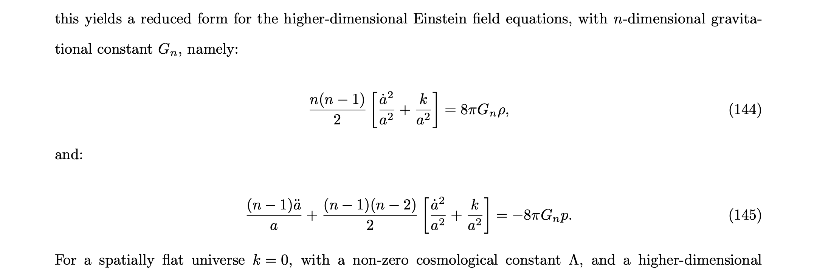Homogeneous, isotropic, dimension-changing universe
Homogeneous, isotropic, dimension-changing universe
Ordinary homogeneity
Ordinary homogeneity
All components of (x) are independent of x
g
μν
Ordinary isotropy
Ordinary isotropy
At every point is invariant under rotations
g
μν
In ordinary GR, the Riemann tensor has Ricci and Weyl curvature parts. The vacuum has =0 so is trivially “homogeneous and isotropy” even e.g. for a black hole ..... but the Weyl tensor is nonzero.To achieve full homogeneity/isotropy, Riemann tensor is invariant under the Euclidean group (i.e. translations and rotations)
R
μν
C
In ordinary FRW...
In ordinary FRW...
The whole Riemann tensor is characterized by the scale parameter a .... and the discrete curvature parameter k
[implicitly there is also a dimension parameter]
[implicitly there is also a dimension parameter]
Analog of FRW for hypergraph
Analog of FRW for hypergraph
Cosmological equation of state: p = α ρ
Derivation of Riemann tensor....
Derivation of Riemann tensor....
Take two geodesics which intersect at some point
Distance scales:
Distance scales:
Discretization
Scale over which tangent space is flat (linearization scale) [fitting a straight line to a curve]
Curvature scale [fitting a circle to a curve]
Scale over which tangent space is flat (linearization scale) [fitting a straight line to a curve]
Curvature scale [fitting a circle to a curve]
[ e.g. for Ricci tensor construction: radius of tube is at linear scale; length is at curvature scale ]
Orthogonality
Orthogonality
“Vectors” are geodesics
Two geodesics that intersect
Take the end of one geodesic; find how far it is to every point on the other geodesic; what is the minimum (“dropping the perpendicular”)
In[]:=
Options[GraphGeodesicsOrthogonalQ]={"TransitivelyReduce"False,"UndirectedGraph"False,"AverageGeodesics"True,"MaxGeodesics"False,"MinGeodesics"False};GraphGeodesicsOrthogonalQ[causalGraph_,initialVertex_,finalVertex1_,finalVertex2_,options:OptionsPattern[]]:=Module[{transitiveReduction,geodesic1,geodesic2,projections,minimalProjections,minimalProjectionTargets,innerProduct},transitiveReduction=If[OptionValue["TransitivelyReduce"]True,TransitiveReductionGraph[causalGraph],causalGraph];geodesic1=FindShortestPath[If[OptionValue["UndirectedGraph"]True,UndirectedGraph[transitiveReduction],transitiveReduction],initialVertex,finalVertex1];geodesic2=FindShortestPath[If[OptionValue["UndirecteedGraph"]True,UndirectedGraph[transitiveReduction],transitiveReduction],initialVertex,finalVertex2];projections=FindShortestPath[If[OptionValue["UndirectedGraph"]True,UndirectedGraph[transitiveReduction],transitiveReduction],Last[geodesic1],#]&/@geodesic2;minimalProjections=Select[projections,Length[#]Min[Length/@projections]&];minimalProjectionTargets=Last/@minimalProjections;If[OptionValue["MaxGeodesics"]True,innerProduct=Max[(First[First[Position[geodesic2,#]]]-1)&/@minimalProjectionTargets],If[OptionValue["MinGeodesics"]True,innerProduct=Min[(First[First[Position[geodesic2,#]]]-1)&/@minimalProjectionTargets],If[OptionValue["AverageGeodesic"]True,innerProduct=Mean[(First[First[Position[geodesic2,#]]]-1)&/@minimalProjectionTargets],innerProduct=(First[First[Position[geodesic2,#]]]-1)&/@minimalProjectionTargets]]];(innerProduct0)]
In[]:=
Options[GraphGeodesicInnerProduct]={"TransitivelyReduce"False,"UndirectedGraph"False,"AverageGeodesics"True,"MaxGeodesics"False,"MinGeodesics"False,"Normalize"True};GraphGeodesicInnerProduct[causalGraph_Graph,initialVertex_,finalVertex1_,finalVertex2_,options:OptionsPattern[]]:=GraphGeodesicInnerProduct[causalGraph,initialVertex,finalVertex1,finalVertex2,"InnerProduct",options]GraphGeodesicInnerProduct[causalGraph_Graph,initialVertex_,finalVertex1_,finalVertex2_,"InnerProduct",options:OptionsPattern[]]:=Module[{transitiveReduction,geodesic1,geodesic2,projections,minimalProjections,minimalProjectionTargets,innerProduct},transitiveReduction=If[OptionValue["TransitivelyReduce"]True,TransitiveReductionGraph[causalGraph],causalGraph];geodesic1=FindShortestPath[If[OptionValue["UndirectedGraph"]True,UndirectedGraph[transitiveReduction],transitiveReduction],initialVertex,finalVertex1];geodesic2=FindShortestPath[If[OptionValue["UndirectedGraph"]True,UndirectedGraph[transitiveReduction],transitiveReduction],initialVertex,finalVertex2];projections=FindShortestPath[If[OptionValue["UndirectedGraph"]True,UndirectedGraph[transitiveReduction],transitiveReduction],Last[geodesic1],#]&/@geodesic2;minimalProjections=Select[projections,Length[#]Min[Length/@projections]&];minimalProjectionTargets=Last/@minimalProjections;If[OptionValue["MaxGeodesics"]True,innerProduct=Max[(First[First[Position[geodesic2,#]]]-1)&/@minimalProjectionTargets],If[OptionValue["MinGeodesics"]True,innerProduct=Min[(First[First[Position[geodesic2,#]]]-1)&/@minimalProjectionTargets],If[OptionValue["AverageGeodesics"]True,innerProduct=Mean[(First[First[Position[geodesic2,#]]]-1)&/@minimalProjectionTargets],innerProduct=(First[First[Position[geodesic2,#]]]-1)&/@minimalProjectionTargets]]];If[OptionValue["Normalize"]True,innerProduct/(Length[geodesic2]-1),innerProduct]]GraphGeodesicInnerProduct[causalGraph_Graph,initialVertex_,finalVertex1_,finalVertex2_,"OrthogonalQ",options:OptionsPattern[]]:=(GraphGeodesicInnerProduct[causalGraph,initialVertex,finalVertex1,finalVertex2,"InnerProduct",options]0)GraphGeodesicInnerProduct[causalGraph_Graph,initialVertex_,finalVertex1_,finalVertex2_,"HighlightedGraph",options:OptionsPattern[]]:=Module[{transitiveReduction,geodesic1,geodesic2,projections,minimalProjections},transitiveReduction=If[OptionValue["TransitivelyReduce"]True,TransitiveReductionGraph[causalGraph],causalGraph];geodesic1=FindShortestPath[If[OptionValue["UndirectedGraph"]True,UndirectedGraph[transitiveReduction],transitiveReduction],initialVertex,finalVertex1];geodesic2=FindShortestPath[If[OptionValue["UndirectedGraph"]True,UndirectedGraph[transitiveReduction],transitiveReduction],initialVertex,finalVertex2];projections=FindShortestPath[If[OptionValue["UndirectedGraph"]True,UndirectedGraph[transitiveReduction],transitiveReduction],Last[geodesic1],#]&/@geodesic2;minimalProjections=Select[projections,Length[#]Min[Length/@projections]&];HighlightGraph[If[OptionValue["UndirectedGraph"]True,UndirectedGraph[transitiveReduction],transitiveReduction],Join[Style[Subgraph[If[OptionValue["UndirectedGraph"]True,UndirectedGraph[transitiveReduction],transitiveReduction],#],AbsoluteThickness[5],ColorData[1,3],Dashed]&/@minimalProjections,{Style[Subgraph[If[OptionValue["UndirectedGraph"]True,UndirectedGraph[transitiveReduction],transitiveReduction],geodesic1],AbsoluteThickness[5],ColorData[1,1]],Style[Subgraph[If[OptionValue["UndirectedGraph"]True,UndirectedGraph[transitiveReduction],transitiveReduction],geodesic2],AbsoluteThickness[5],ColorData[1,2]]}]]]
First, find pairs of orthogonal geodesics.... then you can set up parallel transport....
Full Ricci tensor case, involving a tube traced out by balls:
[Finding an “average distance between balls” ; first, get balls with the same surface area ; then set up a bijection between the elements on the surfaces ; then find the bijection for which the average distance between corresponding points is minimized [or it could be something other than minimized] ] Construct the “tidal tensor” ... by comparing the average surface distance between balls with the distance between their centers.
<< Consider the bundle of geodesics between these balls ...
<< Consider the bundle of geodesics between these balls ...
Riemann tensor : instead of transporting a whole ball, transport a Frenet frame like object
[ This definition is as independent of dimension as the definition of a geodesic ]
This is effectively a thick geodesic
Length scales:
scale of the small balls
scale of the distance between balls [which you swing around to get the Ricci scalar]
scale of the small balls
scale of the distance between balls [which you swing around to get the Ricci scalar]
From the “frames” look at the bundles of geodesics; that gives Riemann tensor
If you look at the shape of a cross-section of the bundle, gives you sectional curvature.
If you look at the shape of a cross-section of the bundle, gives you sectional curvature.
Tensor indices
Tensor indices
Homogeneous & Isotropic
Homogeneous & Isotropic
E.g. a random sprinkling of h & i manifold will be h & i
[ n is the spatial topological dimension ]
Light cone structure is independent of time; determined by the structure of the characteristics for the solutions of these equations
The equations describe the time evolution of a spatial slice
In essence Hubble radius ~ a
Volume of universe:
- number of nodes (n)
- a^d [where a is the overall scale size of the universe]
<< - z [average graph distance between two points] >>
- number of nodes (n)
- a^d [where a is the overall scale size of the universe]
<< - z [average graph distance between two points] >>
z ~ n^(1/d) [ n is total number of nodes ]
But z ~ a
a ~ n^(1/d)
[ cf. Myhrheim-Meyer estimator ]
But z ~ a
a ~ n^(1/d)
[ cf. Myhrheim-Meyer estimator ]
Another assumption:
Another assumption:
“It’s not a fractal” [ in the sense that its topological dimension is the same as its Hausdorff dimension ]
Dimension Evolution
Dimension Evolution
Diffusional Behavior
Diffusional Behavior
Rules exchange segments on neighboring geodesics
The dimension determines effectively the fanout of geodesics;
“segment exchange” can be either the in fanlike direction, or in the cross-fiber direction
“segment exchange” can be either the in fanlike direction, or in the cross-fiber direction
Cross-fiber is like moving material around in a given spherical shell; while fanlike is concentrating radially or not [or deforming the radius of shells]
Probability for a fanlike change is determined by effective topological dimension (probability of fanlike change is 1/(effective topological dimension) )
Volume element determined by Hausdorff dimension
